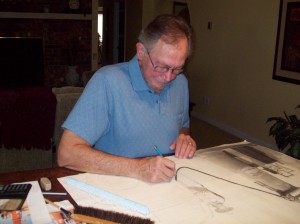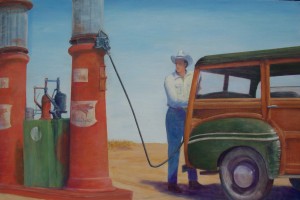Whether I paint on board, linen, or canvas I prime my substrate with four sanded smooth coats of gesso. I then make a preliminary pencil drawing on tracing paper and transfer it to the substrate.

I attempted to paint this particular painting “Old Woodie” in (as near as possible) an egg tempera technique. I am the first one to admit that I failed to accomplish this feat a hundred percent, however it turned out to be an acceptable painting and was an eye-opening experience. The painting was done on 1/4″ Masonite board.
We tend to think of egg tempera as a picture made up of delicate details with fine brush stroking and a smooth matte finish with no paint buildups.
Artists working in true egg tempera use small, rapid brushstrokes to blend their colors and soften the edges. It is a laborious process requiring skill and patience. This is why most artist choose to work with watercolor, oil or acrylics.

Since I wanted to paint this picture using the egg tempera technique with acrylic paints, I tried and tested the brushwork techniques akin to that medium. It was trying indeed. I found the controlled execution lacks spontaneity, but it did offer an opportunity to reacquaint myself with the beauty of fine lines and precise formal renderings.
For a medium mixture I used a 50:50 ratio of water/acrylic-matte medium ensuring a good adhesion and giving the painting surface the dry, matte finish so characteristic of egg tempera paintings. I used the sable-like watercolor brushes for the small areas and detail work just so it would be prevalent with the tempera technique. When finished I protected the painting with three coats of sanded smooth satin varnish.
